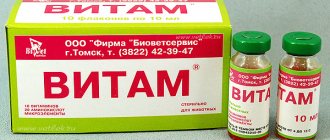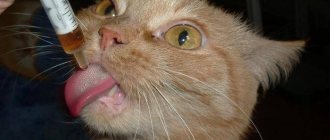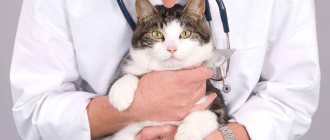One of the most common diseases found in all domestic animals is helminthiasis, that is, infection with worms. The waste products of these parasites poison the body, disrupting the functioning of internal organs. To avoid complications, every owner should be aware of how and what is the best way to deworm a cat for treatment or prevention.
What is deworming and why is it needed?
Deworming is measures aimed at destroying existing parasites or preventing their appearance. Worms are harmful not only to animals, but also to humans. For the safety of the whole family, it is important to prevent their appearance by all means.
For prevention purposes
Preventative treatment is carried out not only for those animals that constantly go outside, but also for couch potatoes. The likelihood of a pet becoming infected is lower, but it still exists. Risk factors include feeding with natural products, namely meat, fish and offal. Such food is often contaminated with parasites. The second source of danger is grass brought from the street.
Before vaccinations and travel
After vaccination, the immune system is weakened, since all its forces are aimed at fighting the introduced virus. A recently vaccinated animal is more vulnerable to helminths. Therefore, before vaccination, it must be dewormed.
Before going abroad, you will have to find out in advance how to properly deworm a cat. The mustachioed traveler will need a veterinary passport and veterinary certificate form No. 1. These documents contain notes on vaccinations and all anti-parasitic treatments. The certificate is issued on the basis of a veterinary passport, clinical examination, fluorescent diagnostics and the results of an analysis for helminths. Its validity period is only 5 days, so all necessary procedures are carried out in advance.
Pre-treatment will also be necessary for those who decide to go to the country. The likelihood of infection in nature is higher, and without additional protection, the pet runs the risk of acquiring parasites.
Deworming is mandatory for mature animals 2-4 weeks before mating. This is necessary to ensure that the expectant mother does not get helminthiasis - it is forbidden to treat a pregnant cat with almost all drugs. In addition, there is always a risk of infection of the offspring.
As a treatment
Infected pets are treated not once, but twice. The first time, anthelmintic drugs kill adult individuals, and the second time, they kill grown-up worms that have hatched from eggs.
How to deal with parasitic worms in pets?
It is better to prevent any disease than to treat it. Therefore, first of all, attention should be paid to preventive measures, namely:
- Do not feed animals raw meat, especially pork, or raw fish.
- Do not allow animals to feed in garbage cans.
- Stop dogs from eating feces.
- Prevent your pets from getting fleas.
All these measures, however, do not exclude the possibility of uninvited guests appearing in the animal’s body. After all, even if an animal never goes outside, parasite eggs can be brought indoors on the owner’s shoes, and flies flying into the room can carry parasites into the food bowl. Therefore, there is no way to do without the use of anthelmintic drugs. It should also be taken into account that the presence of parasites does not always manifest itself externally in any way. Therefore, feeding animals with anthelmintic drugs is as mandatory a procedure as vaccination against infectious diseases.
When and how often to worm a cat
Calculating how to properly deworm a cat is quite easy. To do this, you need to understand the purpose of the event:
- Prevention
. If the pet is kept at home, then it is treated 2 times a year. If access to the street is not limited, then an anthelmintic is given every quarter.
- Treatment
. The anthelmintic is given twice with a break of 10-14 days. Remember that the anthelmintic does not affect eggs.
The schedule can be shifted when traveling abroad or outdoors, undergoing surgery or vaccination, as well as participating in exhibitions. To avoid complications, including overdose, be sure to listen to the advice of your veterinarian and follow the basic rules.
How does worm infection occur?
The main sources of worm infection in domestic animals are:
- a female that was not dewormed before mating/mating
- feces of other animals
- homemade or raw food
- street shoes
- fleas, mice, birds, etc.
There are many sources of worm infection even in animals that do not walk outside, so worms in dogs are no more common than in cats living at home. It is important to remember that the main sources of infection of pets are the owners themselves.
Deworming rules
Antihelmintics are given an hour before morning feeding. This eliminates the interaction with gastric juice of increased acidity observed during digestion. Neglecting this recommendation may impair absorption or change the properties of the medicinal substance.
Due to the toxicity of the drugs, only healthy animals are allowed for treatment. Anthelmintics should be given with extreme caution to kittens and pregnant and lactating pets.
The dosage of the medicine depends on the weight of the pet, so read the instructions before use. To be safe, consult your veterinarian. He may advise you to adjust general recommendations depending on the patient's condition. Here it is better to play it safe: too small a dose will not give the desired effect, and too much will lead to intoxication.
It is important to check for flea infestation before use. Fleas quickly spread worm eggs, preventing recovery. Until they are eliminated, treatment will be pointless.
To strengthen the immune system, prebiotics are given along with anthelmintics - dietary fiber that stimulates the growth of beneficial bacteria in the intestines. When carrying out a procedure for therapeutic purposes, be sure to get tested after repeated treatment and take care of more thorough hygiene of the tray.
"Helminthal". Description of the drug and reviews
The drug is available in the form of a suspension. It has a wide spectrum of action against round and tape helminths in all phases of development.
The drug is used from three weeks of age for prophylactic as well as therapeutic purposes. The product is used for nematodes and cestodes, as well as mixed infestations. The dosage of the drug is 1 ml per 4 kg. Gelmintal should be given once with food.
Many dog owners speak positively about the product. They say no side effects have been identified.
Features of some groups of animals
Toxins in anthelmintics poison not only worms, but also the cat’s body. True, in the latter case, toxic substances do not have a significant effect. The danger arises only with low immunity, which is typical for sick animals and kittens. The drug will have to be taken with extreme caution during pregnancy and lactation, since all substances from the body are transferred to fragile babies.
In kittens
The first treatment of a kitten is carried out no earlier than three weeks of age. After this, it is processed quarterly, deviating from the schedule only before vaccination. Vaccinations are given starting from 2-3 months, followed by revaccination after 15-30 days. 10 days before vaccination, the baby is dewormed.
The selection of the drug and dosage is made by the veterinarian. The most commonly used are Dironet and Milbemax.
In pregnant and lactating females
Most anthelmintic drugs have a negative effect on embryos, causing abnormalities in their development and causing miscarriages. Veterinarians recommend treatment no later than 10 days before mating. This rids the pet of existing parasites in advance and gives her immunity from the appearance of new ones until the end of feeding.
If you are behind schedule, be sure to make an appointment at the veterinary clinic and find out how to deworm a pregnant cat. In the third trimester, taking medications is at its most dangerous, so it may be necessary to reduce the dosage indicated in the instructions.
Expectant mothers are given low-toxic anthelmintics: Drontal, Profender and Dirofen. The ban includes Polyvercan, Prazitel and Kanikquantel Plus. Their effect on the body is too aggressive and can lead to unpleasant consequences. In the absence of serious symptoms and maintaining good health, you can limit yourself to taking folk remedies.
With nursing pets, things are also not so simple. The first month of drug treatment should be avoided. When infected, babies are temporarily separated from their mother. In the second month after birth, it is allowed to take Prazicide, Aziprin or Drontal.
Is it possible to give deworming to a cat during estrus?
You will be surprised how many parasites will come out if you drink a glass of regular...
Parasites will leave the body in 3 days! You just need to drink on an empty stomach...
Helminth infections - diseases caused by parasitic worms - are far from uncommon in pets. And diagnosis, prevention and treatment of such diseases are among the main problems of animal owners. After all, parasitic worms not only bring suffering to dogs and cats, some of their types can also be transmitted to humans. Therefore, for those who have a pet, it is important to know the various nuances and conditions for carrying out anthelmintic measures, in particular, how possible it is to deworm while in heat.
Have you been trying to get rid of PARASITES for many years?
Head of the Institute: “You will be amazed at how easy it is to get rid of parasites by taking every day...
Read more "
Flatworms that parasitize domestic animals
The helminths most commonly found in pets are either flatworms or nematodes. Flatworms, in turn, are divided into flukes and tapeworms or cestodes.
Among flukes or trematodes, the most common is the cat fluke, which causes a dangerous disease, opisthorchiasis, which leads to severe liver damage, and both animals and people can become infected with this worm. However, a cat or dog suffering from opisthorchiasis does not pose a danger either to other four-legged animals or to humans, since it is impossible to become directly infected with the cat fluke. Infection with this parasite occurs exclusively when eating fish belonging to the order Cyprinidae, for example, crucian carp, bream or roach.
These trematodes have a complex development cycle, and on their life path from egg to mature individual they replace two intermediate hosts - a freshwater mollusk (for example, a pond snail) and fish.
Tapeworms, or cestodes, are also common parasites of pets. The most famous among them are:
- Wide tape.
- Pork tapeworm.
- Cucumber tapeworm.
- Sheep brain.
- Echinococcus.
Types and characteristics of parasites living in the body of animals
The broad tapeworm is not directly transmitted from animals to humans. Both people and animals become infected with this worm by eating fish containing its larvae. For pork tapeworm, domestic animals are intermediate hosts. This helminth is a tissue parasite for cats and dogs. The larvae of this parasite, cysticerci or finnae, are localized in the muscles, eyes or brain of the intermediate host, which can become a source of infection only for those who eat it. Therefore, it is not a person who can become infected from his cat or dog, but, on the contrary, he can infect his pet himself if an adult form of the worm lives in his intestines.
The cucumber tapeworm is a fairly common parasite, and its prevalence is due to fleas. These insects are intermediate hosts for this worm. By biting off its fleas, an animal can swallow an insect carrying a parasite larva. Also in humans, when accidentally swallowing such a flea, the larva develops into the adult form of the cestode.
Echinococcus and sheep brainworm are the most dangerous helminths among those that can be transmitted to humans from a pet. For both of these parasites, carnivorous mammals are the main hosts in which these worms parasitize the intestines. A dog can become infected with these worms by eating the internal organs of animals that contain the larval form of echinococcus or sheep brainworm. In the human body, these worms are able to live in their larval form.
In the case of sheep brainworm, the brain is affected; in the case of echinococcus, both the brain and other organs are affected. The larval stage of echinococcus consists of blisters, sometimes reaching large sizes. Without timely surgical removal of the larvae (coenurs) of the brain or hydatid cyst, disease with these helminthiasis can be fatal. The greatest danger of these worms lies precisely in the possibility of their direct transmission to people from animals that are the source of the eggs of these parasites.
Diseases of domestic animals caused by roundworms
Of all the parasites in pets, nematodes or roundworms are the most common. Young dogs and cats are especially susceptible to these parasites. The most common diseases caused by nematodes are:
- toxascariasis;
- toxocariasis;
- trichinosis.
The causative agents of toxascariasis, toxascarid nematodes, live only in the intestines of the host, causing gastroenteritis and other gastrointestinal problems. In especially severe cases, intestinal blockage and even rupture of its walls may occur. Toxocariasis is a more serious problem. The fact is that toxocara in its larval stage affects the internal organs of the animal, such as the heart and lungs. Additionally, a pregnant female with toxocariasis can pass the parasites to her fetus, and puppies or kittens may already be born with the disease. Therefore, prevention, diagnosis and treatment of toxocariasis even before pregnancy is so important.
Both of these parasites can also infect humans. A very serious disease, trichinosis, which occurs in both animals and humans, is caused by the nematodes Trichinella. These parasites cannot be transmitted from a sick animal to other animals or people through normal contact. The larvae of this worm live in the muscle tissue of the host. If an animal has eaten raw meat, such as pork, there is a risk of infection. Animals that eat rats can also get this disease.
How to deal with parasitic worms in pets?
It is better to prevent any disease than to treat it. Therefore, first of all, attention should be paid to preventive measures, namely:
- Do not feed animals raw meat, especially pork, or raw fish.
- Do not allow animals to feed in garbage cans.
- Stop dogs from eating feces.
- Prevent your pets from getting fleas.
All these measures, however, do not exclude the possibility of uninvited guests appearing in the animal’s body. After all, even if an animal never goes outside, parasite eggs can be brought indoors on the owner’s shoes, and flies flying into the room can carry parasites into the food bowl. Therefore, there is no way to do without the use of anthelmintic drugs. It should also be taken into account that the presence of parasites does not always manifest itself externally in any way. Therefore, feeding animals with anthelmintic drugs is as mandatory a procedure as vaccination against infectious diseases.
Currently, the means by which you can deworm four-legged pets are very numerous. And when choosing a drug, you should listen to the recommendations of a veterinarian, and also read reviews about a particular drug. It is necessary to give an anthelmintic to a cat or dog without waiting until the dog loses weight and mature worms appear in its feces.
The use of antihelminthic drugs for preventive purposes should be regular. Since kittens or puppies can be born with worms, the first dose of antihelminthics should be taken at a fairly early age - after 21 days have passed since their birth. However, if there is an intrauterine infection of the cubs with larvae traveling through the bloodstream of a pregnant dog, then they are unlikely to be born strong and healthy. Therefore, first of all, it is necessary to ensure that the animal is free of parasites even before pregnancy. And here the question may arise about whether it is possible to deworm while in heat.
Regularity of anthelmintic procedures
According to all the rules, anthelmintic procedures should be carried out even before the onset of estrus. The frequency of use of anthelmintic drugs recommended by many experts is 3 or 4 months. However, anthelmintics are toxic substances that not only kill parasites, but also harm the health of the dog or cat. Therefore, you should not overuse them, especially since it is still not always possible to completely rid the animal of parasites - simply the number of worms is reduced to a level that does not cause significant harm to the body. From this point of view, preventive measures can be performed once every six months.
When using antihelminthic medications, one should not forget about their side effects, and therefore it is necessary to strictly follow the instructions and strictly adhere to the dosage.
You will be surprised how many parasites will come out if you drink a glass of regular...
Parasites will leave the body in 3 days! You just need to drink on an empty stomach...
It is advisable to deworm animals after the summer has ended. In summer, the likelihood of helminthic infestation is very high. First of all, this applies to dogs and cats that their owners let out for a walk. It is recommended to give anthelmintic drugs to the dog 15-20 days before the start of estrus, especially if mating is planned. On the one hand, the dog will not become pregnant if it is infected with worms, on the other hand, there will be enough time to remove the toxic drug from the dog’s body. If a dog becomes pregnant, then it is no longer possible to deworm her - medications can harm the fetus.
There are cases when estrus occurs earlier than expected, even before antihelminthic measures have been taken. What to do in this case?
It is known that in people, if worms are discovered during menstruation, expelling them should be delayed until the end of the critical days. As for animals, deworming during estrus is, in principle, possible, but not advisable. Firstly, the animal licks itself frequently, and therefore increases the likelihood that it will reinfect itself with parasites. This will weaken the effect of the treatment, or even make the procedure ineffective. Secondly, the drug can remain in the body after conception, which can pose a threat to the normal development of the fetus. Therefore, if you nevertheless decide to worm your dog into heat, then you should refrain from the subsequent planned mating.
These are the basic recommendations for carrying out anthelmintic procedures in pets. Remember that timely and correctly taken measures for the prevention and treatment of helminthiasis in pets will prevent serious health problems for your pets and reduce the risk of infection for yourself.
- Bactefort
- Roundworms
- Other parasites
- Other parasites (bacteria)
- Giardia
- Opisthorchiasis
- Pinworms
- Parasites in animals
- Preparations for parasites
- Miscellaneous
- Trichomoniasis
- Chlamydia
- Tapeworm
What drugs exist
Preparations intended for deworming cats come in narrow and broad spectrum. The former affect a specific type of parasite, while the latter affect several at once.
Thanks to the variety of release forms, the anthelmintic can be easily selected individually. It can be given in the form of tablets or suspensions, or simply dripped onto the withers. Each form has its own advantages and disadvantages. After reading them, you will understand how easier it is to deworm your cat.
Pills
The advantages of the tablet form are a longer shelf life and the possibility of localizing the action of the drug in a specific part of the gastrointestinal tract. This is achieved by applying a special coating that allows the active substance to be transported to the required location.
Among the tablets that veterinarians recommend:
- Dironet;
- Dirofen;
- Drontal;
- Azinox;
- Prazicide;
- Kanikquantel Plus;
- Panacur Granules.
The downside of such medications is their slow action and the impossibility of use for frequent bouts of vomiting. The owners also have problems with feeding the tablets. Because of the bitter taste, animals often refuse to take them on their own, so the procedure is carried out forcibly.
Suspensions
First of all, suspensions are attractive due to their fast action. When the active substances are crushed, their surface area increases, allowing contact with a larger part of the organ or tissue infected with worms.
Another advantage is a more pleasant taste, which is achieved in production using flavoring agents. The taste of meat is accepted with a bang by mustachioed pets. Suspensions are often produced together with a dispenser syringe, which allows you to measure the required amount of medicine and inject it into the cat’s mouth.
From the available brands you can choose:
- Piradek;
- Dironet;
- Dirofen;
- Drontal;
- Prazicide.
The last 4 anthelmintics are available not only in the form of tablets, but also in the form of a suspension. If you have several pets, then treat them with one drug, choosing a convenient release form.
The disadvantages of suspensions include short service life and physical instability. The resulting sediment disrupts the uniformity of dosing.
Drops
Drops are applied only to the withers - a place that the animal cannot reach. To get the effect, just a couple of drops are enough, so owners choose this form because of its economical consumption and ease of use.
Popular drops include:
- Profender;
- Bars Spot-On;
- Advocate;
- Stronggold.
Swimming is excluded for 2 days before and after use. Water can wash away the protective barrier on the skin or the droplets themselves. In the first case, the pet will receive more toxins, and in the second, it will not feel the effect and will remain vulnerable to worms.
Please note that due to their gentle action, drops are not suitable for direct infestations. If helminthiasis is detected, it is recommended to use other anthelmintics, and the drops will act as a protective agent after getting rid of the worms.
Folk remedies
Traditional medicine is recommended for young people, pregnancy and lactation. It has no harmful effects on the body and is suitable even for weakened pets. Its only drawback is its slow action. Treatment will take from 7 to 30 days. There is also a risk of an allergic reaction.
To remove worms use:
- Infusion of wormwood and tansy. Grind the plants in equal proportions, pour boiling water over them and filter to remove small particles. For 1 tbsp. l. 250 ml of water is enough. The cooled infusion is taken an hour before morning feeding for 7 days.
- Pumpkin seed infusion. Pour boiling water over the peeled and crushed seeds, adding a little honey. After 12 hours, strain the infusion and serve half an hour before meals. The medicine can be given orally or through enemas.
- Tansy flowers. In addition to the green part, the buds themselves also have healing properties. Add peppermint, buckthorn bark and wild carrot seeds. Prepare the same way with tansy and wormwood, taking 2 times more herbal mixture. Give it three times a day for 3 days.
Before using folk remedies, be sure to consult your veterinarian. Some recipes may be dangerous.
It is strictly forbidden to use onions and garlic. These products contain chemicals that destroy feline red blood cells. Hemolytic anemia may be added to helminthiasis. Poisoning by these plants is accompanied by severe vomiting, diarrhea, pale mucous membranes and difficulty breathing.
"Drontal." Description and reviews
We have already told you when to worm puppies, then we will look at different drugs. Knowing this information, you can independently choose the appropriate product.
"Drontal" is a drug that has a broad anthelmintic effect. Available in the form of tablets, which are designed for 10 and 35 kilograms.
Dog breeders consider this drug to be quite effective, but expensive. Some owners had problems with the product and their pets experienced side effects. There is an opinion that there are now many counterfeits of this drug on the market, which is why many dog breeders have switched to other products.
How to give your cat medicine
Inexperienced owners often struggle trying to figure out how to deworm a cat that refuses medication. Not for the first time, spit out tablets gradually dissolve due to saliva, but still do not reach their destination. A frightened animal hides in the farthest corner and prevents any attempts to extract it from there.
This situation can be avoided if you think through everything in advance. The most important thing is to eliminate as much as possible all the exciting moments:
- Do not open medications in the presence of your pet. Measure out the required dose of tablet or suspension before the cat arrives.
- Wait for the right moment. It is easier to act in a state of rest or strong fascination with another object. Try gently waking your sleeping pet or giving him a pill when he persistently asks for food.
If you can’t do everything quickly, secure the cat on your lap with a blanket or towel, leaving only the head free. Gently open your jaws and place the tablet on the root of your tongue. After this, close your mouth and stroke your pet’s neck, provoking the swallowing reflex.
For the most aggressive and persistent, it is recommended to make a decoy by wrapping the tablet in a tasty piece of minced meat or cottage cheese. The medicine can also be crushed, mixed with water and served as a suspension.
A suspension or paste is more readily accepted by many animals, but there can be problems here too. If you are not yet comfortable with the deworming procedure, carry it out with the help of a second person. Later, you will learn how to quickly and deftly give your cat medicine.
Extra cycle of a cat
Veterinarians use the term “extra cycle” to refer to the reproductive cycle of an animal. It is divided into several phases:
- Proestrus (precursor). Lasts 1-4 days. At this time, the hormonal background changes, and the first deviations in the animal’s behavior appear. The domestic cat becomes very affectionate towards its owners. He constantly asks for attention, rubs himself, rolls on the floor, but does not allow cats near him yet.
- Estrus. Lasts 1-1.5 weeks. This is the peak of hormonal activity when slight clear discharge appears. The animal becomes uncontrollable: periodically it emits a loud, prolonged howl and arches strongly while stroking. She presses her chest to the floor, and puts her back up, as if inviting the male to mate.
- Metestrus (after-leak). Lasts 2-19 days. If the cat manages to mate, pregnancy already occurs during this period (sometimes it can be false). Interest in males at this time gives way to pronounced aggression.
- Anestrus. This is the time between heats, the so-called “interestrus”. The cat calms down completely. Behavioral signs of sexual activity disappear. Appetite and daily routine return to normal.
If during a period of high hormonal activity the cat failed to mate and, accordingly, there was no pregnancy, after some time the estrus repeats.
Can deworming cause harm?
Complications can occur if the dosage is incorrect. An insufficient amount of the substance will keep the worms alive - they will continue to multiply and poison the body, which will affect the worsening of symptoms.
If kittens are overdosed or dewormed with adult medications, vomiting and diarrhea may occur. Gastrointestinal upset severely dehydrates the body, so animals will need the help of a veterinarian. Prolonged diarrhea in adult animals is safe for no more than 2 days, and in kittens – only 6-12 hours.
If you are hypersensitive to the active substances, itching or other allergic reactions, including anaphylactic shock, may occur. Other possible complications include:
- breathing problems (shortness of breath);
- blood pressure surges;
- excessive salivation and foaming (due to the bitterness of the medicine);
- stomach bleeding and kidney dysfunction;
- rapid weight loss.
In severe cases of helminthiasis and an excessively weakened body, taking anthelmintics can lead to multiple organ failure syndrome. This deadly pathology leads to rapid failure of all internal organs and systems. It is impossible to save an animal with such a diagnosis, so veterinarians recommend a full diagnosis before deworming in severe cases.
"Prasicide." Description and reviews
The suspension is used for therapeutic and prophylactic purposes against cestodiasis and nematodiasis for puppies from two weeks of age.
The drug should be given once during morning feeding with food or on the root of the tongue. The drug must be administered using a syringe without playing. The dosage of the product is 1 ml per 1 kg of puppy’s body weight. Before use, shake the bottle for 30 seconds. A starvation diet and the use of laxatives are not required.
Many people who have used the drug say that it is effective. In addition, it is quite easy to give to the animal. Unfortunately, some puppies experienced side effects - depression, drooling, etc.
"Milprazone." Description and reviews
This combination drug is intended for puppies and dogs weighing from 500 grams to 5 kg. Active ingredients: milbemycin oxime and praziquantel.
The drug has proven itself to be an effective remedy. Those who have used it say that Milprazone really helps fight internal parasites. In addition, no side effects are observed when used even in small puppies.
Brief abstracts about estrus in cats: everything you need to know
A reminder for anyone who adopts a female kitten:
- Puberty occurs at 6-9 months.
- On average, estrus lasts a week and, in the absence of mating, repeats every 2-3 weeks.
- The only way to calm a cat is to induce ovulation with a special massage that simulates sexual intercourse.
- The use of hormonal agents or surgical sterilization should be considered before the onset of estrus.
- Repeated “empty” periods of sexual heat cause diseases of the genital organs - ovarian cysts, pyometra, hydrometra.
Now that you know how long a cat’s heat lasts and how difficult it is to calm a pet, let’s move on to the main thing. Sterilization is the most favorable option if you do not plan to regularly breed a cat and get kittens from her. Read about this operation in a separate article.
"Polyvercan". Description and reviews
This product is intended for puppies and dogs. Available in the form of sugar cubes. The drug is aimed at destroying round and flat helminths.
The cubes can be dissolved in a small amount of drinking water. 1 cube is designed for 10 kg of animal body weight. Can be used from two weeks of age.
Reviews about this product are quite varied. Has anyone experienced side effects from this drug? For others, the process went quite well, without any problems.











